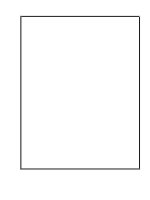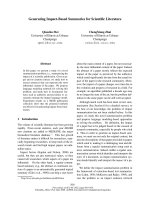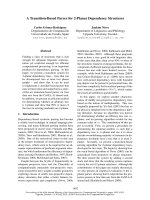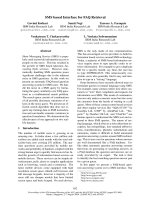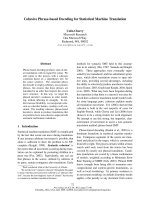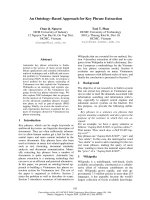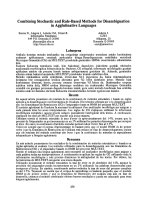Cellulose ester based membranes for osmotic processes
Bạn đang xem bản rút gọn của tài liệu. Xem và tải ngay bản đầy đủ của tài liệu tại đây (3.98 MB, 206 trang )
CELLULOSE ESTER BASED MEMBRANES FOR
OSMOTIC PROCESSES
ONG RUI CHIN
NATIONAL UNIVERSITY OF SINGAPORE
2014
CELLULOSE ESTER BASED MEMBRANES FOR OSMOTIC
PROCESSES
ONG RUI CHIN
(B. Eng.) National University of Singapore
A THESIS SUBMITTED
FOR THE DEGREE OF DOCTOR OF PHILOSOPHY
DEPARTMENT OF CHEMICAL AND BIOMOLECULAR ENGINEERING
NATIONAL UNIVERSITY OF SINGAPORE
2014
i
Declaration
I hereby declare that the thesis is my original work and it has been written by me in
its entirety. I have duly acknowledged all the sources of information which have
been used in the thesis.
This thesis has also not been submitted for any degree in any university previously.
____________________________
Ong Rui Chin
7 March 2014
ii
ACKNOWLEDGEMENT
First of all, I would like to extend my utmost gratitude and appreciation to my supervisor,
Professor Chung Tai-Shung from the Department of Chemical and Biomolecular Engineering,
National University of Singapore (NUS). His continuous encouragement, patience and guidance
have been the very essential throughout my PhD journey. He is never hesitant in sharing
knowledge and always inspires me with his enthusiasm and passion towards membrane research.
I would also like to sincerely thank my PhD thesis advisory committee members, Professor Ting
Yen Peng and Professor Chen Shing Bor for their valuable suggestions on the areas for
improvement throughout my candidature in NUS. I would also like to thank Professor Donald R.
Paul, for sharing his professional knowledge on the fundamental polymer science and membrane
transport. Thanks are also due to Professor Y. C. Jean and Dr. H. Chen for sharing their
knowledge in PALS analyses for polymeric membranes which are very essential in most of my
work.
I would like express my gratitude towards Eastman Chemical Company for the research funding
through the project titled “Investigation of Novel Materials for the Forward Osmosis Process”
(grant number R-279-000-315-597) and synthesizing the cellulose esters which are the core of
my PhD work. Special thanks are due to Dr. Bradley Helmer and Dr. Jos de Wit for their kind
advice in my research work. Thanks are also due to the Singapore National Research Foundation
(NRF) (grant number R-279-000-336-281 and R-279-000-339-281) for the financial support.
iii
I would also like to convey my personal appreciation to all former and current members of our
membrane research group, especially Dr. Wang Kaiyu, Dr. Teoh May May, Dr. Wang Yan, Dr.
Zhang Sui, Dr. Li Xue and Dr. Natalia Widjojo for sharing their valuable knowledge without any
reservation. Special thanks are due to Ms. Zhong Peishan and Ms. Fu Xiu Zhu for their valuable
comments on my PhD dissertation. I would also like to thank Ms. Nguyen Thi Mai Thao, Ms. Li
Xiaoman, Mr. Khoo Yong Seng, Tony, Ms. Liang Jiayue and Ms. Lin Xiaochen for the
assistance given to me.
My sincere thanks are due to all staff members in the Department of Chemical and Biomolecular
Engineering, especially Mr. Ng Kim Poi, Mr. Chia Pai Ann and Mr. Liu Zhicheng. My gratitude
is also extended to Mr. Lim Poh Chong at Institute of Material Research and Engineering
(IMRE) for his help on XRD analysis.
Last but not least, I would like to thank my parents, sisters and husband for their unconditional
love and support.
iv
TABLE OF CONTENTS
ACKNOWLEDGEMENT ii
TABLE OF CONTENTS iv
SUMMARY ix
LIST OF TABLES xiv
LIST OF FIGURES xvi
NOMENCLATURE xxi
Chapter 1 Introduction 1
1.1 An Overview of Osmosis and Osmotic Pressure 1
1.2 Classifications of Osmotic Processes 3
1.3 The Development and Applications of Forward Osmosis 6
1.3.1 Desalination 6
1.3.2 Liquid food concentration and pharmaceutical applications 8
1.3.3 Other applications 9
1.4 Challenges in Forward Osmosis 11
1.4.1 Concentration polarization 11
1.4.2 Reverse solute diffusion 13
1.4.3 Development of draw solutes 14
1.5 Membranes for Forward Osmosis 18
1.5.1 Asymmetric membranes with integrally-grown selective layer by phase inversion 21
1.5.2 Composite membranes 25
v
1.6 Cellulose Esters 34
1.7 Mass Transport in Forward Osmosis 37
1.7.1 External concentration polarization 38
1.7.2 Internal concentration polarization 40
1.7.3 Solute reverse flux 43
1.8 Research Objectives and Thesis Organization 43
Chapter 2 Formation of Cellulose Triacetate Forward Osmosis Membranes 47
2.1 Introduction 47
2.2 Experimental 48
2.2.1 Materials 48
2.2.2 Membrane fabrication 49
2.2.3 Positron annihilation lifetime spectroscopy (PALS) 50
2.2.4 Molecular simulations by Material Studio 51
2.2.5 Fourier transform infrared spectroscopy (FTIR) analysis 52
2.2.6 Mean pore size and pore size distribution 52
2.2.7 Forward osmosis tests and salt rejection tests 53
2.3 Results and Discussion 55
2.3.1 Morphology of CTA membranes 55
2.3.2 Membrane morphology characterized by PAS 57
2.3.3 Effects on solvent systems on the CTA membrane morphology 62
2.3.4 Mean pore size and pore size distribution 69
2.4 Conclusions 77
Chapter 3 Novel Cellulose Esters for Forward Osmosis Membranes 79
vi
3.1 Introduction 79
3.2 Experimental 82
3.2.1 Materials 82
3.2.2 Membrane preparation 85
3.2.3 Morphological studies 86
3.2.4 Fractional free volume calculations and density determination 86
3.2.5 Pure water permeability, salt rejection and salt permeability tests 87
3.2.6 Forward osmosis tests 87
3.3 Results and Discussion 88
3.3.1 Viscosity curves and critical concentration evaluation 88
3.3.2 Membrane morphology 90
3.3.3 Performance of cellulose ester membranes 94
3.3.4 Effects of DS and functional group on membranes’ FO performance 97
3.3.5 FO performance of CAB_M membranes at different draw solution concentrations . 105
3.4 Conclusion 107
Chapter 4 Free Volume, Fundamental Water and Salt transport Properties of Novel
Cellulose Esters and Their Relationships to the Functional Groups 108
4.1 Introduction 108
4.2. Experimental 111
4.2.1. Chemicals 111
4.2.2 Dense film preparation 112
4.2.3 Positron annihilation lifetime spectroscopy (PALS) 113
4.2.4 Equilibrium water uptake and salt partition coefficient measurements 115
vii
4.2.5 Pure water and salt permeability measurements 116
4.2.6 Water and salt diffusivity 117
4.2.7 Water/salt selectivity 117
4.3 Results and discussion 118
4.3.1 Free volumes of cellulose ester films 118
4.3.2 Equilibrium water uptake, salt partition coefficient, K
s
and solubility parameters 122
4.3.3 Permeability and diffusivity characteristics of various cellulose esters 126
4.3.4 Solubility selectivity, α
K
, and diffusivity selectivity, α
D
128
4.4 Conclusions 132
Chapter 5 Novel Hydrophilic Cellulose Ester Supported Thin Film Composite Forward
Osmosis Membranes 133
5.1 Introduction 133
5.2 Materials and Methods 135
5.2.1 Fabrication of cellulose ester membrane supports 135
5.2.2 Interfacial polymerization and post-treatment methods of flatsheet TFC-FO
membranes 137
5.2.3 Characterizations of cellulose ester membrane supports and TFC-FO membranes 138
5.2.4 Forward osmosis tests 139
5.2.5 Determination of transport and structural parameters 139
5.3 Results and Discussion 140
5.3.1 Characteristics of cellulose ester membrane supports 140
5.3.2 Characteristics of TFC-FO membranes subjected to various post-treatment methods
143
viii
5.3.3 Forward osmosis performance of TFC-FO membranes 144
5.3.4 PALS analyses 147
5.3.5 Seawater desalination 148
5.3.6 Performance comparisons with existing TFC-FO membranes reported in literatures
150
5.4 Conclusions 152
Chapter 6 Conclusions 153
REFERENCES 155
A LIST OF JOURNAL PUBLICATIONS 182
ix
SUMMARY
The beginning of 21
st
century marks the start of an era of energy and water crises due to the
depletion of oil reserves and the tremendous population growth across the globe. Water shortages
are becoming a worrying phenomenon as the demand for freshwater exceeds the supply.
Furthermore, the rapid depletion of energy sources has made energy intensive separation
processes uneconomical in the long run. These pressing issues have forced mankind to seek an
energy efficient way to produce clean water from alternative sources such as seawater and
brackish water. Reverse osmosis (RO) process is a very established and matured water
purification technology which has been widely used in many countries around the world.
However, the greatest concerns on RO process are its intensive energy consumption and the
limitations in terms of recovery. In countries where energy resources are extremely limited, a
more energy saving technology is preferred for the production of clean water.
Recently, forward osmosis (FO) process has been studied extensively by many scientists to
explore its feasibility to be applied in water treatment. The FO process requires no hydraulic
pressure to achieve water flux and solute rejection unlike RO does. Instead, the driving force for
water transport is obtained from a solution with a high osmotic pressure, namely draw solution,
and the separation can be achieved via a semi-permeable membrane which selectively passes
through water molecules while rejecting other solutes including monovalent ions like sodium
chloride (NaCl). The driving force provided by osmotic pressures utilized in FO can be
significantly higher than the hydraulic pressures used in RO, thus theoretically FO may result in
a higher water flux than RO. Therefore, FO is an attractive alternative to the current energy
x
intensive processes for water reuse and desalination. Many studies have shown that FO offers
various advantages such as higher rejections towards a wide range of contaminants, lower
membrane fouling propensities, lower energy consumption when the process does not require
draw solute regeneration and many more over conventional water purification processes.
In the first part of this work, the fundamental science and engineering of cellulose triacetate
(CTA) membrane formation were explored by fabricating the membranes using different solvent
systems and characterizing the membrane morphology using advanced tools such as positron
annihilation lifetime spectroscopy (PALS). It was found that the choice of solvents for
membrane fabrication significantly affects the morphology of as-cast membranes and their FO
performance. The CTA membrane cast using NMP as the main solvent showed poor NaCl
rejection but high water flux, whereas the CTA membrane cast using dioxane as the main solvent
had excellent NaCl rejection but low water flux. SEM and PAS data revealed that the sublayer of
CTA membranes cast from dioxane has a close-cell and much denser structure compared to that
cast from NMP. With the addition of acetic acid into the membrane casting solution, the
resulting membrane had a significantly more porous and open-cell sublayer structure. In addition
to the pore forming ability of acetic acid, FTIR spectra confirmed the formation of acetic
acid/dioxane complexes in the casting solution. Thus, as validated by PAS spectra, the free
volume of the active layer of the resultant CTA membranes increases after the addition of acetic
acid into the dioxane/acetone casting solution. Molecular simulations were also conducted to
examine CTA polymeric chains in different solvent systems and to witness different CTA chain
behavior in these solvents that leads to significant differences in the as-cast membrane
morphology.
xi
Subsequently, a wide range of cellulose esters were newly synthesized and studied for their
potential as FO membrane materials. Synthesis and evaluation of novel cellulose esters with a
range of chemical compositions targeted for forward osmosis (FO) membrane fabrication have
been carried out. Preliminary studies on the effects of the degree of substitution (DS) of hydroxyl
(OH), acetyl (Ac) and propionyl (Pr) or butyryl (Bu) on permeation characteristics were
conducted. We observed that water solubilities and free volume of cellulose esters possess great
influence on the salt permeabilities as the incorporation of more water molecules into the
polymer matrices contributes to higher salt passage. High hydrophobic functional group content
leads to a great salt rejection due to low water solubility and hydrated free volume. However, a
very high content of bulky side groups results in an increase in free volume due to poor chain
packing and leads to a low salt rejection. High OH content results in high salt permeation. Highly
hydrophobic cellulose esters are unable to form selective layers without defects under normal
casting conditions due to rapid phase inversion.
For further understanding on the fundamental properties of various cellulose esters, transport
properties including salt and water partition coefficients, permeability and diffusivity of various
newly synthesized cellulose esters were evaluated in this study in order to investigate the
relationship among them as a function of molecular structure. Dense flat cellulose ester films
were prepared and studied to minimize the influence of membrane fabrication technique,
morphology and processing history on transport properties. PALS was employed to characterize
the free volume of these cellulose esters. It was found that the transport and free volume
properties can be correlated with the functional groups and their content in cellulose esters. High
xii
hydroxyl content leads to a high hydrophilicity hence resulting in a high water and salt partition
coefficient. Hydrophilic cellulose esters suffer from low water/salt selectivity. On the other hand,
an increase in bulky and hydrophobic propionyl or butyryl groups generally enhances cellulose
esters’ selectivity but decreases the permeability. However, a very high content of bulky
functional group causes a drop in selectivity due to poor chain packing and the enlarged free
volume as confirmed by PALS. Experimental results suggest that cellulose esters with moderate
content of both hydroxyl and bulky side groups have the best diffusivity selectivity and may be
suitable as membrane materials for salty water separation. An upper bound relationship between
solubility selectivity and water partition coefficient was also observed in these cellulose esters as
suggested in previous literatures for other polymers.
In the last part of this work, a hydrophilic cellulose ester with a high intrinsic water permeability
and a water partition coefficient was chosen to fabricate highly porous membrane supports for
flat-sheet thin film composite FO (TFC-FO) membranes. The polyamide selective layer is
formed by interfacial polymerization. The performance of TFC-FO membranes prepared from
the hydrophilic cellulose ester groups clearly surpasses those prepared from cellulose esters with
moderate hydrophilicity. Post-treatments of TFC-FO membranes using sodium dodecyl sulfate
(SDS) and glycerol followed by heat treatment further enhanced the water flux without
compromising the selectivity. PALS analyses have confirmed that the SDS/glycerol post-
treatment increases the free volume size and fractional free volume of the polyamide selective
layer. The post-treated TFC-FO membranes exhibit a remarkably high water flux of up to 90
LMH when the selective layer is oriented towards the draw solution (i.e., PRO mode) using 1M
NaCl as the draw solution and DI water as the feed. For seawater desalination, the membranes
xiii
display a high water flux up to 35 LMH using a 2M NaCl draw solution. These water fluxes are
the highest ever reported in literatures.
xiv
LIST OF TABLES
Table 1.1 A list of common polyelectrolytes employed for LbL membrane fabrication. 31
Table 2.1 VEPFIT results for the S parameter analysis of top and bottom layers of CTA
membranes 60
Table 2.2 Physiochemical properties of solvents and non-solvents 62
Table 2.3Water contact angles of glass plate, CA and CTA membranes 63
Table 2.4 Hansen solubility parameters of solvents and non-solvents 65
Table 2.5 Mean pore size (µp), geometric standard deviation (σp) and molecular weight cut off
(MWCO) of CTA membranes 70
Table 2.6 FO performance of CTA membranes before annealing. Draw solution: 2M NaCl, feed:
DI water. 72
Table 2.7 FO performance of CTA membranes after annealing. Both top layer faces draw
solution (DS) and bottom layer faces DS orientations were tested. Draw solution: 2M NaCl, feed:
DI water. 74
Table 2.8 Annealed CTA membranes’ rejections towards NaCl at 10 bar operating pressure. 77
Table 3.1 Degrees of substitution (DS) of hydroxyl (OH), acetyl (Ac), propionyl (Pr) and butyryl
(Bu) functional groups of cellulose esters used in this study. 83
Table 3.2 Critical concentrations of cellulose esters in NMP and compositions of casting
solutions. 89
Table 3.3. Pure water permeability, A (LMH bar
-1
), salt permeability, B (LMH), salt rejection, R
s
at 10 bar 94
Table 3.4 FO performance of cellulose ester membranes. 96
xv
Table 3.5 FFV calculated from the Bondi group contribution method and solubility parameters of
cellulose esters. 101
Table 4.1 Degrees of substitution (DS) of hydroxyl (OH), acetyl (Ac), propionyl (Pr) or butyryl
(Bu) functional groups, glass transition temperatures (T
g
) and densities of cellulose esters used in
this study. 111
Table 4.2 Water diffusivity coefficients D
w
and salt diffusivity coefficients D
s
of cellulose ester
films. 127
Table 5.1 Summary of Water Contact Angle, Porosity, Mean Effective Pore Size (µ
p
), MWCO,
and PWP of Cellulose Ester Membrane Supports 141
Table 5.2 PRO and FO Performance of TFC-FO Membranes using 1.0 M NaCl Draw Solution
144
Table 5.3 The transport parameters A, B and the structural parameter S of TFC-O-II membranes,
calculated by the Excel-based error minimization algorithm developed by Tiraferri et al. [233].
The related coefficients of determination, R
2
for both water and salt fluxes and the corresponding
coefficient of variation (CV) are obtained from the same method 146
Table 5.4 Free Volume Radii and Fractional Free Volume of Selective Layers on TFC-FO
Membranes Based on CAP-O Supports Evaluated by PALS 147
xvi
LIST OF FIGURES
Figure 1.1 Water flux and hydraulic pressure in RO, FO and PRO processes. ∆P is the hydraulic
pressure exerted and ∆π is the osmotic pressure difference between the solutions. 4
Figure 1.2 Relationship between water flux Jw, ∆P and ∆π. 5
Figure 1.3 Schematic diagram of general FO desalination process. 7
Figure 1.4 Illustration of osmotic pressure, π profile of FO through asymmetric at PRO and FO
modes. The subscript F, D, b and m refer to feed, draw, bulk and membrane surface respectively.
∆π
eff
denotes the effective osmotic driving force. 13
Figure 1.5 Structures of symmetric and asymmetric membranes. 18
Figure 1.6 Comparison of structures of FO and RO membranes. 19
Figure 1.7 Interfacial polymerization of m-phenylenediamine and trimesoyl chloride. 27
Figure 1.8 Scheme of the deposition of 2 bilayers of polyelectrolytes onto a porous support. 32
Figure 1.9 Chemical structure of an repeating unit of cellulose triacetate 35
Figure 1.10 Acetyl, propionyl and butyryl functional groups 35
Figure 2.1 Morphology of the FO membrane cast from CTA/NMP/Acetone dope composition 56
Figure 2.2 Morphology of the FO membrane cast from CTA/Dioxane/Acetone dope composition
56
Figure 2.3 Morphology of the FO membrane cast from CTA/Dioxane/Acetone/Acetic acid dope
composition 56
Figure 2.4 S parameters versus positron incident energy (or depth) for the CTA membranes cast
from different solvent systems fitted through VEPFIT analysis in three-layer mode. Both top and
bottom layers were examined under PAS. 58
xvii
Figure 2.5 Close up view on the S parameters versus positron incident energy from 0 to 5keV
for the CTA membranes cast from different solvent systems fitted through VEPFIT analysis in
three-layer mode. Both top and bottom layers were examined under PAS. 59
Figure 2.6 R parameters versus positron incident energy (or depth) for the CTA membranes cast
from different solvent systems fitted through VEPFIT analysis in three-layer mode. Both top and
bottom layers were examined under PAS. 61
Figure 2.7 Snapshots from Material Studio showing the simulated amorphous cell constructed
from CTA polymer chain with 30 repeating units in different solvent systems 64
Figure 2.8 Structures of (a) carboxylic acid dimers and (b) carboxylic acid-dioxane complexes 66
Figure 2.9 FTIR spectra of pure dioxane, pure acetic acid and dioxane acetic acid mixtures 67
Figure 2.10 FTIR spectra of pure dioxane, pure acetic acid and dioxane acetic acid mixtures
with wave number ranging from 2500 – 3500cm
-1
68
Figure 2.11. FTIR spectra of pure dioxane, pure acetic acid and dioxane acetic acid mixtures
with wave number ranging from 500 – 1000cm
-1
69
Figure 2.12 The pore size distribution curves of annealed CTA membranes 71
Figure 2.13 FO performance of annealed CTA/dioxane/acetone/acetic acid membranes. Draw
solute: NaCl, feed: DI water. Top-DS indicates top layer facing NaCl solution and Bottom-DS
indicates bottom layer facing NaCl solution. 75
Figure 2.14 FO performance of annealed CTA/dioxane/acetone/acetic acid membrane. Draw
solute: NaCl, feed: 3.5 wt% NaCl solution. Top-DS indicates top layer facing draw solution and
Bottom-DS indicates bottom layer facing draw solution. 76
xviii
Figure 3.1 Map of design strategy for novel cellulose esters as a function of hydrophilic DS(OH)
vs. the ratio of hydrophobic DS(Pr) for CAP or DS(Bu) for CAB to the total DS of bulky side
groups. 84
Figure 3.2 Viscosity curves of cellulose esters as a function of polymer concentration 88
in NMP solutions at a shear rate of 10 s
-1
. 88
Figure 3.3 (a) Membrane morphology observed under FESEM. 91
Figure 3.3 (b) Membrane morphology observed under FESEM. 92
Figure 3.4 Phase diagram of various CAP and CA398-10. 93
Figure 3.4 DS(OH) against the ratio of DS(Pr) for CAP or DS(Bu) for CAB to the total DS of
bulky side groups. Membranes prepared from within the range marked by the two dotted lines
have better FO performance 98
Figure 3.5 Water fluxes and reverse salt fluxes of CAB_M membranes at PRO and FO modes as
a function of draw solution concentration using DI water as the feed. 105
Figure 3.6 Water fluxes of CAB_M membranes at PRO and FO modes as a function of draw
solution concentration using model seawater (3.5 wt% NaCl) as the feed. 106
Figure 4.1 Chemical structures of cellulose ester polymers where R can be substituted by
different functional groups to form CA, CAP and CAB. 112
Figure 4.2 The static permeation cell for the measurement of salt permeability P
s
. 116
Figure 4.3 Free volume sizes (V
dry
) and fractional free volumes (FFV
dry
) of dry cellulose ester
films against the degree of substitution of hydroxyl group (DS(OH))* 118
Figure 4.4 Free volume sizes (V
wet
) and fractional free volumes (FFV
wet
) of wet cellulose ester
films against the degree of substitution of hydroxyl group (DS(OH))* 120
xix
Figure 4.5 Percentage variation in free volume size at wet state compared to that at dry state
against the degree of substitution of hydroxyl group (DS(OH)). 121
Figure 4.6 Equilibrium water uptake vs. the degree of substitution of hydroxyl group (DS(OH))*
123
Figure 4.7 Salt partition coefficient vs. the degree of substitution of hydroxyl group (DS(OH))*
124
Figure 4.8 Equilibrium water uptakes vs. the solubility parameters of cellulose ester films 125
Figure 4.9 Pure water permeability (P
w
) and salt permeability (Ps) against the degree of
substitution of hydroxyl group (DS(OH))* 126
Figure 4.10 Solubility selectivity α
K
vs. the degree of substitution of hydroxyl group, propionyl
group or butyryl group for various cellulose esters* 128
Figure 4.11 Diffusivity selectivity α
D
vs. the degree of substitution of hydroxyl group and
propionyl group or butyryl group for various cellulose esters* 129
Figure 4.12 Correlation between water partition coefficient K
w
and solubility selectivity α
K
. The
straight line was plotted using the empirical upper bound relation K
w
/K
s
= λ
K
/(K
w
)
βK
proposed by
Geise et al. [45] where λ
K
and β
K
are constants; λ
K
= 1 and β
K
= 2. 130
Figure 4.13 Correlation between water diffusivity coefficient D
w
and diffusivity selectivity α
D
.
The straight line was plotted using the empirical upper bound relation D
w
/D
s
= λ
D
/(D
w
)
βD
proposed by Geise et al. [45] where λ
D
and β
D
are constants; λ
D
= 1.4E-7 and β
D
= 2. 131
Figure 5.1 The chemical structures, compositions and basic properties of cellulose esters used in
this work 136
Figure 5.2 FESEM micrographs of (a) CAP-O and (b) CAB-M membrane supports. 140
Figure 5.3 Pore size distributions of CAP-O and CAB-M membrane supports. 142
xx
Figure 5.4 FESEM micrographs of (a) TFC-O-I, (b) TFC-O-II and (b) TFC-M-II membranes. 143
Figure 5.5 (a) Water flux and (b) reverse salt flux for TFC-O-II membranes at PRO and FO
modes using DI water feed solutions and different concentrations of NaCl draw solutions. 146
Figure 5.6 Water flux for TFC-O-II membranes at PRO and FO modes using 3.5 wt% NaCl
(model seawater) feed solutions and different concentrations of NaCl draw solutions. 149
Figure 5.7 Comparison of water flux performance for FO desalination process using 2.0M NaCl
draw solution. PDA modified PSf TFC-FO [111], CAP TFC-FO [137], sPPSU TFC-FO hollow
fiber [230], sPPSU TFC-FO flatsheet [135]. 151
xxi
NOMENCLATURE
A pure water permeability (L m
-2
h
-1
bar
-1
)
B salt permeability (L m
-2
h
-1
)
C
D,m
solute concentration in draw solution at membrane surface (mol L
-1
)
C
f
solute concentration in feed (mol L
-1
)
C
F,m
solute concentration in feed at membrane surface (mol L
-1
)
C
p
solute concentration in permeate (mol L
-1
)
d
h
hydraulic diameter (m)
D
s
bulk diffusion coefficient of draw solute (m
2
s
-1
)
FFV fractional free volume
i van’t Hoff factor
J
s
solute flux (g m
-2
h
-1
)
J
w
water flux (L m
-2
h
-1
)
K solute resistivity (s m
-1
)
K
s
salt partition coefficient
k mass transfer coefficient (m s
-1
)
L characteristic length (m)
P
s
salt permeability (cm
2
s
-1
)
P
w
pure water permeability (cm
2
s
-1
bar
-1
)
R gas constant, 8.314 (J mol
-1
K
-1
)
R
s
solute rejection
Re Reynold’s number
S structural parameter (m)
xxii
Sc Schmidt number
Sh Sherwood number
V
p
polymer specity volume
α
D
diffusivity selectivity
α
K
solubility selectivity
ε porosity
τ tortuosity
π
D,b
bulk draw solution osmotic pressure (bar)
π
D,m
draw solution osmotic pressure at membrane surface (bar)
π
F,b
bulk feed solution osmotic pressure (bar)
π
F,m
feed solution osmotic pressure at membrane surface (bar)
σ membrane reflection coefficient
ρ density (g cm
-3
)
∆P pressure difference (bar)
∆π osmotic pressure difference (bar)
Δx membrane thickness (m)
1
Chapter 1 Introduction
1.1 An Overview of Osmosis and Osmotic Pressure
The history of osmosis can be traced back to early days when mankind utilized salt to preserve
foods. Even though the phenomenon of osmosis was not understood then, mankind found that
foods can be prevented from rotting or decaying by preserving them with salt. The use of salt
draws out the water content in foods and prevents microorganisms from breaking down or
consuming the foods. It was only until 1748 when osmosis observation was first documented by
Jean-Antoine Nollet [1]. Osmosis occurs only when a concentration gradient across the semi
permeable membrane exists. Given a system of semi-permeable membrane separating two
liquids with different concentrations, water molecules will diffuse from solution with low solute
concentration to solution with high solute concentration through the membrane without needing
an input of energy.
Although the occurrence of net water movement across the membrane can be well understood
macroscopically in terms of equilibrium thermodynamics [2], the microscopic mechanisms of the
generation of osmotic pressure and the osmotic driving force for water movement are still being
discussed in many literatures. The interpretation of osmotic pressure often varies in literatures.
The classical interpretation of osmotic pressure is expressed by van’t Hoff equation shown as
follows [3]:
icRT
(1)
where i is the van’t Hoff factor, c is the concentration of all solute species in the solution, R is the
gas constant and T is the temperature. A similar but simpler expression for osmotic pressure was
